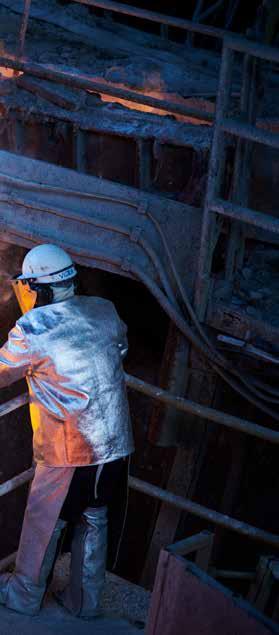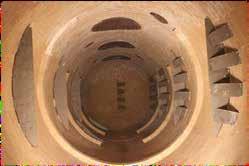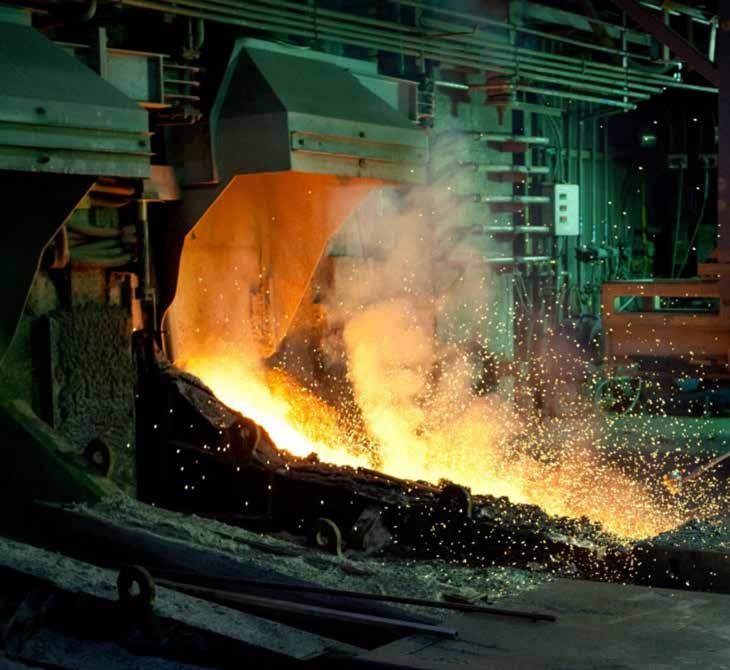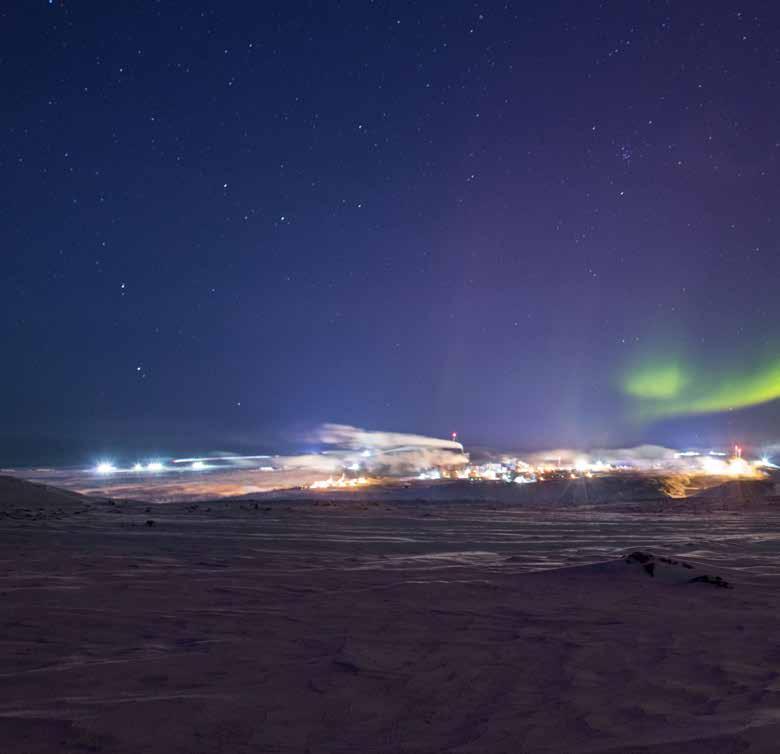
16 minute read
Glencore
strength in diversity

Advertisement
Glencore is one of the world’s largest global diversified natural resource companies and a major producer and marketer of more than 60 commodities. The Group has a footprint in over 35 countries with operations comprising some 150 mining and metallurgical sites and oil production assets.
At the time of writing, in April 2020, the world as we used to know it has largely been put on hold. Precautions against the spread of coronavirus have been introduced all over the world, but they vary widely from country to country and change like the wind. I can therefore only report what has happened in the short period of the initial global response.
Most countries have introduced the kind of measures which require people to stay at home unless their work is considered to be in an ‘essential’ industry. Needless to say, interpretations of this vary, too. In the mining sector, Glencore’s customers are industrial consumers, such as those in the automotive, steel, power generation and battery manufacturing sectors.

While the majority of Glencore’s operations have not been materially impacted to date, in Canada, Glencore’s Raglan (nickel) and Matagami (zinc) operations in Quebec were initially closed, but when the government of Quebec extended the order for all nonessential businesses to remain closed until 4 May, it then classed mining as an essential activity from 15 April, so the operations started looking at options to restart as soon as they could. The Australian Government has also identified mining as an essential activity. All Glencore sites have riskbased plans to support the health and safety of workers and the continuation of business and the company has pledged to do everything in its power to continue running safe, responsible
and sustainable operations across the country. In Colombia, a 19-day quarantine for the country began on 25 March, and was subsequently extended to 27 April. Prodeco’s mining operations in the country remain on care and maintenance, but the port continues to operate. In Peru, operations were halted at the Antamina mine. During the suspension the company undertook to disinfect the camp and increase protocols for those arriving at/departing from the site. While North and South America have had their interruptions, Africa has had more issues. The South African government extended its nationwide lockdown to 30 April, so Glencore’s ferroalloys and two of its coal

(Middleburg and Graspan) operations were put on care and maintenance. A risk-based approach to lifting restrictions has been introduced from 1 May. The economic climate around the mining industry has been volatile recently, to say the least, in some African countries. Governments are keen to obtain a fair reward in return for the exploitation of their mineral assets, but overly tough measures risk jeopardising the overseas investment they depend upon. In Zambia in early April, Glencore announced its intention to suspend its copper and cobalt operations in the country for three months. Reuters quoted Mopani Copper Mines as saying: “In addition to the impacts of a rapid decline in the copper price, Mopani’s situation has been further impacted by the critical disruptions to international mobility, transportation and supply chains arising from Covid-19.” Mopani (MCM) has underground mines, a concentrator, a smelter and a refinery at the Mufulira mine site, with open pits, a concentrator and a cobalt plant at the Nkana mine site in Kitwe. MCM is 73.1% owned by Glencore, 16.9% by First Quantum Minerals and the remaining 10% by Zambia’s mining investment arm ZCCM-IH. The government reacted angrily to the announcement, claiming the company had not given sufficient notice of its intentions, and threatened to revoke Glencore’s mining licences. Glencore has invested billions of dollars sinking new shafts at MCM to try to increase copper production to 140,000 tons a year. The company obviously believes in the operation. Nevertheless, MCM chief executive Nathan Bullock was forcibly prevented from flying home to see his family in Australia and driven back to the mine from Lusaka airport by police. Shortly after that a videoconference was set up between Glencore and Zambia’s ministers of mines, finance, home affairs, and labour. “The government wants to see a win-win situation and respects investors, but we need to protect the interests of Zambians,” mines ministry permanent secretary Barnaby Mulenga said to Reuters in a telephone interview. “We expect to make a lot of progress in this
glencore strength in diversity
meeting.” In early May Mopani Copper Mines announced it would restart mining and provide a 90-day notice period of its intention to place the operations on care and maintenance. During the notice period, the company said, it would discuss “potential solutions to its current challenges” following “constructive discussions” with the Zambian government.
Copper and cobalt
Despite the effects of coronavirus, copper remains an important commodity to Glencore. The company is one of the world’s largest producers and marketers of the metal, producing 1.37 million tonnes in 2019, and selling 4.1 million tonnes through its marketing business to a range of customers in the automotive, electronics and construction industries. Glencore mines and processes copper ore in the key mining regions of Africa, Australia and South America, as well as sourcing and recycling copper scrap in North America and Asia. As a major by-product of copper production, Glencore is also one of the world’s largest producers of cobalt, primarily from the Democratic Republic of Congo (DRC). Katanga Mining Limited (86.3%) operates a large-scale copper-cobalt mine complex producing copper cathodes and cobalt hydroxide in the DRC. Katanga’s assets include the Kamoto underground mine and KOV open pit mine, providing sulphide and oxide ores respectively; and the Kamoto concentrator and Luilu metallurgical plant for the onsite production of refined copper and cobalt. On 29 April 2019, it was announced that Katanga’s 75% subsidiary Kamoto Copper Company (KCC) had commenced a comprehensive business review targeting mining efficiencies and processing improvements as well as enhancements to product quality realizations and overhead cost reductions. There may be scope for margin improvements in the order of $200-$250 million per annum. KCC has defined business priorities including improved efficiencies, maintenance, labour productivity and production quality, while decreasing the costs associated with procurement,
glencore strength in diversity



STOP CORROSION IN HYDROMETALLURGICAL PROCESS EQUIPMENT
Let STEBBINS utilize its 135+ years of experience to handle your corrosion/chemical attack and/or abrasion problems –based on proprietary membranes and chemical/abrasion resistant masonry lining systems for:

Pressure Vessels & Linings Systems Process Storage Tanks Thickeners / Clarifiers Acid Plant Equipment

Quench Vessels Leach / Flotation Tanks Thickeners / Clarifiers Scrubbers Floor / Trench Linings
sourcing and information technology. These improvements are expected to materially increase the cash flow generation of KCC from 2022, when it is projected to achieve targeted life of mine average production of approximately 300ktonnes of copper and 30ktonnes of cobalt. At the end of December last year Katanga announced that Mamoto Copper Company had agreed with La Générale des Carrières et des Mines (Gécamines), its 25% joint venture partner in KCC, to acquire a comprehensive land package covering areas adjacent to KCC’s existing mining concessions. The land includes multiple blocks over the preferred location for construction of a new long-term tailings facility, and multiple other blocks that will enhance KCC’s ability to operate its mines more efficiently. If this agreement is implemented then the risks for KCC’s operations resulting from land constraints described in the company’s
The Best Corrosion Resistant Lining Technology

363 Eastern Boulevard, Watertown, NY 13601 Tel. 1 (315) 782-3000 Fax. 1 (315) 782-0481 WWW.STEBBINSENG.COM
Port Allen, LA ● Greenville, SC ● Portland, OR ● Ottawa, ON ● Port Coquitlam, BC Perth, Australia ● Johannesburg, RSA ● Santiago, Chile ● Seoul, Korea ● Nagpur, India
43-101 Technical Report of 7 November 2019, would be mitigated. Mutanda is another large-scale copper and cobalt producer, also in Katanga province, DRC, producing copper cathodes and cobalt hydroxide. Also in Africa, Mopani Copper Mines Plc is a Zambian registered copper mine owned by Glencore Plc (73.1%) and First Quantum Minerals Ltd (16.9%) with ZCCM-IH owning 10%. In April 2000, Mopani purchased assets of the Zambia Consolidated Copper Mines Limited (ZCCM) comprising underground mines, a concentrator, a smelter and a refinery at Mufulira mine site and underground mines, open pits, a concentrator and a cobalt plant at Nkana mine site in Kitwe. The company invested in three new shafts: Synclinorium, Mindolo Deeps and Mufurila Deeps. At its design depth of 2 km, Mufulira Deeps will be the world’s second deepest, single-shaft underground copper mine, a shade behind the 2.1km-
glencore strength in diversity
deep Resolution Copper Mine in the state of Arizona, USA, and will add 25 years to the life of the mine. In Australia, Glencore has copper mining and processing operations in Queensland and New South Wales. In North Queensland its copper mining and processing operations include the Mount Isa Mines complex, Ernest Henry Mining near Cloncurry, and copper refinery in Townsville. Operating since 1924, Mount Isa Mines remains one of Australia’s largest industrial complexes, operating two separate mining and processing streams - copper and zinc-lead-silver. The Mount Isa copper operations host two underground mines, including

Australia’s deepest underground copper mine at 1,900 metres. Ernest Henry Mining is a copper and gold mining and processing operation which began production in 1998 as an open pit mine and in 2011 transitioned to underground mining as part of a $589 million life of mine extension project. Copper ore is processed at the on-site concentrator and trucked to Mount Isa Mines for smelting into copper anode. In New South Wales, with a mining history spanning over 140 years, Glencore’s CSA Mine is Australia’s highest grade copper mine, and at 1,600 metres deep, it is also the second deepest underground copper mine in the country. Located in Cobar, Central

glencore strength in diversity
Western New South Wales, CSA Mine produces copper concentrate with a silver by-product. The product is then transported via rail to Port Waratah in Newcastle, from where it is shipped to smelters around the world. In 2019 in Australia, own sourced copper production of 194,600 tonnes was 15,800 tonnes (8%) lower than in 2018, mainly relating to weatherrelated disruptions in Q1, the impact of which was caught up over the following quarters.
Zinc and lead
Glencore mines and processes zinc and lead ores in Australia, South America, Kazakhstan and Canada. It also smelts

and refines zinc and lead at processing operations in Australia, Canada, Spain, Italy, Germany, the UK and Kazakhstan. In 2019, own sourced zinc production of 1,077,500 tonnes was in line with 2018, reflecting the effects of stronger production (mine restarts) in Australia and Peru, largely offset by reduced own sourced production at Kazzinc for safety reasons and expected lower zinc production from Antamina in Peru, due to mine scheduling. Over half of Glencore’s total zinc and lead reserves and resources are located in Australia, where Mount Isa Mines and McArthur River Mine host the world’s No.1 and No.2 zinc resource bases.
The North Queensland zinc operations include an integrated supply chain comprising mining, processing, transport and logistics, as well as port facilities. The zinc operations at Mount Isa include the George Fisher underground mine, zinc-lead concentrator, zinc-lead filter plant and lead smelter. Glencore also owns the high-grade Lady Loretta underground mine near Mount Isa, where production was temporarily suspended in 2015 when the price of zinc collapsed. In

December 2017, after the price had recovered, Glencore appointed Redpath Australia to run the mine on a contract basis for its remaining six year lifespan. Another zinc operation, McArthur River Mine in Australia’s Northern Territory is around 970 kilometres south-east of Darwin. Established as an underground operation in 1995, MRM converted to open pit mining in 2006. MRM produces zinc and lead in concentrates which are transported by road from the mine site to Glencore’s Bing Bong loading facility on the Gulf of Carpentaria. Current mine life extends to 2036. Zinc production in Australia of 597,600 tonnes in 2019 was 65,100 tonnes (12%) higher than in 2018, reflecting the full-year contribution from Lady Loretta mine, following its 2018 restart, and improved processing rates at McArthur River. Lead production of 213,300 tonnes was 37,500 tonnes (21%) higher than in 2018, mainly relating to Lady Loretta.
glencore strength in diversity
In North America, zinc production of 111,400 tonnes was 10,300 tonnes (10%) higher than in 2018, mainly reflecting higher throughput at Matagami in Quebec, as it accesses a wider section of the deposit. In South America, own sourced zinc production of 93,600 tonnes was in line with 2018, reflecting the recent restart of the Iscaycruz mine in Peru, but offset by challenging mining conditions at Aguilar in Argentina. Own sourced lead production of 32,300 tonnes was 9,600 tonnes (23%) lower than in 2018, mainly relating to Aguilar.

Nickel
Glencore is a leading producer and marketer of nickel, with assets in Australia, Canada and Europe. Around two-thirds of all nickel is used in the production of stainless steel, with the remainder used for applications including super-alloys, batteries and electroplating. Glencore is one of Australia’s largest nickel and cobalt producers, and with more than 30 years of nickel reserves, it has one of the longest life of mine reserves. Murrin Murrin is a worldclass hydrometallurgical nickel project located between Leonora and Laverton in the northeastern Goldfields region of Western Australia. Processed nickel and cobalt are transported via rail to Kwinana, south of Perth, for export to customers worldwide. In Canada, Glencore’s Sudbury Integrated Nickel Operations (Sudbury
INO) include exploration, two underground mines (Nickel Rim South and Fraser), Strathcona Mill and the Sudbury Smelter. The company has been mining nickel-copper ores in the Sudbury area of northern Ontario since 1928. The facilities are spread throughout the 60 kilometre-long, oval-shaped geological formation known as the Sudbury basin. Nickel and copper are the primary metals but cobalt and precious metals, such as gold, silver, platinum and

palladium are also produced. Sudbury INO is looking to develop one of the world’s first mines wholly operated by battery electric-powered vehicles (EVs). The Onaping Depth Project, currently under construction and expected to come on-stream in 2023/24, is collaborating with EVproducers to ensure all parties are fully prepared for an all-electric mining operation. Just a few years ago, Sudbury INO was at a point where, without further
investment, the site’s mines were expected to reach the end of their life cycle as early as 2023. On the other side of the world, on the South Pacific island of New Caledonia, Koniambo Nickel is a joint venture owned by the Société Minière du Sud Pacifique (51%) and Glencore (49%). The mine and smelter started production in 2014, but production targets have not yet been met due to a series of problems with the smelter. Glencore’s own sourced nickel production of 120,600 tonnes in 2019 was 3,200 tonnes (3%) lower than in 2018, mainly reflecting a number of maintenance stoppages at Koniambo, including a crane failure in December 2019. Murrin Murrin’s own sourced nickel production of 36,600 tonnes was 1,100 tonnes (3%) higher than in 2018. Own sourced cobalt production of 3,400 tonnes was 500 tonnes (17%) higher, reflecting strong plant performance and higher year-over-year grades.
Coal
While Glencore has its eyes set on the future with its interests in copper, nickel and cobalt, it has not turned its back on a more traditional commodity – coal, despite pressure from the green lobby. The company operates 26 mines in 21 mining complexes across Australia, Colombia and South Africa. Coal production of 139.5 million tonnes in 2019 was 10.1 million tonnes (8%) higher than in 2018, mainly reflecting the full-year effects of the acquisitions of Rio Tinto’s Hunter Valley Operations (May 2018) and Hail Creek (August 2018). Australian coking production of 9.2 million tonnes was 1.7 million tonnes (23%) higher than in 2018, while Australian thermal and semi-soft production of 79.2 million tonnes was 6.5 million tonnes (9%) higher than in 2018, reflecting the fullyear contributions from HVO and Hail Creek. In Colombia, Prodeco’s production of 15.6 million tonnes was 3.9 million tonnes (33%) higher than in 2018, reflecting additional mine development activities carried out in the base period, while Cerrejòn’s 2019 production was constrained by dust emissions control requirements. South African thermal production of 26.9 million tonnes was broadly in line with 2018. Glencore operates four coal complexes there, producing thermal coal for export and domestic power generation. These include the Goedgevonden Complex, an open-cut mine, in a joint venture with ARM Coal. The Impunzi Complex is a large export thermal coal mining operation located 110km east of Johannesburg, while Izimbiwa Coal, through its subsidiaries, owns five mines near Middelburg
glencore strength in diversity
and Kendal. Finally, the Tweefontein Complex is thermal coal complex near Johannesburg. Glencore is Australia’s largest coal producer, with 16 mining operations across New South Wales and Queensland. Coal is exported from the ports of Abbot Point, Dalrymple Bay, Wiggins Island Coal Export Terminal, RG Tanna coal terminal (in Queensland) and from the Port of Newcastle (in NSW). The company’s interest in coal began with the acquisition in 1998 of the Cumnock and Mount Owen coal mines in Australia. The Cumnock mine is now part of Glencore’s Ravensworth Operations in New South Wales. Its NSW Hunter assets also include mines at Bulga, Liddell, Mangoola, Integra and Mount Owen, while Glencore’s Queensland interests include Collinsville Open Cut, Newlands Coal, Hail Creek, Oaky Creek and Rolleston Open Cut. While stressing the company’s commitment to a low carbon future, CEO Ivan Glasenberg reaffirmed Glencore’s faith in the coal industry in the company’s recent annual report. “Glencore is well positioned to play a key role in aiding the various transitions to a low-carbon economy,” he wrote, “with our responsible approach to producing and sourcing a diversified portfolio of commodities, some of which are absolutely critical in enabling the shift to a low-carbon world. “We also believe that high-quality coal will continue to be part of the overall energy mix well into the future. Population growth, urbanisation and rising living standards are expected to contribute to increased global energy requirements in the coming decades. “The need for affordable and stable baseload power generation is expected to underpin coal demand growth, primarily in Asia, even as it declines in Europe and the US. Our modelling, and indeed that of the International Energy Agency’s (IEA) Stated Policies Scenario, indicates that thermal coal demand is expected to continue to grow to 2030.”










